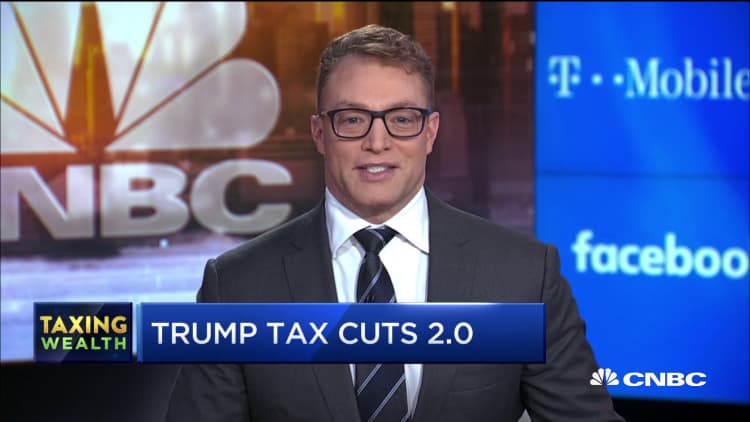‘Tax Cuts 2.0’ could include a rate reduction for the middle class. Here’s who would benefit most
- Reducing the 22% marginal rate to 15% would deliver a $770 billion tax cut through 2025, according to an analysis by the Tax Foundation.
- However, the benefit to the middle class would be minimal because not much of their income is taxed at 22%.
- In mid-November, Larry Kudlow, Trump’s top economic advisor, told CNBC’s “Closing Bell” that any plans for a so-called Tax Cuts 2.0 are in the “very preliminary stages right now.”
Don’t be surprised if a proposal billed as a middle-class tax cut emerges from the White House at some point next year.
With the president’s hope to make it an election issue — as recently described by his top economic policy advisor in an interview with CNBC — the idea is to lower taxes on America’s middle earners in a package dubbed “Tax Cut 2.0.” Yet one of the early ideas floated — reducing the 22% marginal rate to 15% — could miss the mark.
“That actually wouldn’t do much of anything to cut taxes for the middle class,” said Daniel Bunn, director of global projects for the Tax Foundation, an independent tax policy research group.

“If cutting the rate doesn’t really accrue to those folks, then maybe you look at broadening eligibility for refundable tax credits as a more direct route for a middle-class tax cut,” Bunn said.
The first round of tax cuts under the Trump administration — delivered via the 2017 Tax Cuts and Jobs Act — largely benefited the wealthy in its first full year of being in effect, critics say.
On average, U.S. households paid about $1,300 less in individual income taxes in 2018 than they would have under the previous law, according to an estimate from the Tax Policy Center, which also does independent analyses of tax policy. About 65% paid less, 6% paid more and the remaining 29% paid about the same.
However, broken down by income, the picture varies significantly: Households with less than about $25,000 got an average tax cut of about $40, compared with about $800 for those with income from about $48,000 to $86,000, and about $33,000 in tax savings for those with $733,000 or more in income (the top 1%).
In mid-November, Larry Kudlow, Trump’s top economic advisor, told CNBC’s “Closing Bell” that any plans for Tax Cuts 2.0 are in the “very preliminary stages right now.”
“This thing will not be completed for many months and it will be released as a strategic pro-growth document for the campaign,” said Kudlow, director of the National Economic Council. “We want to see middle-income taxpayers get the lowest possible rates.”
He also said: “Whether we get to 15% on a middle-class tax rate — I don’t know. Sounds like a pretty good idea to me.”
While there’s no certainty whether that rate would be included, Bunn’s group examined the effect of reducing the current 22% marginal rate to 15%. (The other existing rates, which apply to certain brackets of income, are 10%, 12%, 24%, 32%, 35% and 37%.)

In short, while reducing that one rate would be a $770 billion tax cut through 2025, the benefit to the middle class would be minimal because not much of their income is taxed at 22%. For singles, that rate applies to taxable income (after all deductions and credits ) of $39,476 to $84,200 in 2019. For married couples, the range is $78,951 to $168,400.
The median U.S. household income is about $63,200, according to the U.S. Census Bureau.
“You would have some increase in after-tax income for the middle class, but it’s 0.001%, which rounds to zero,” Bunn said.
And, the wealthiest taxpayers would again benefit the most, the Tax Foundation’s analysis shows. Those in the 90th to 95th percentile would see after-tax income increase by 2.45%.
More from Personal Finance:
Make these 6 moves to be financially prepared for retirement
These are the retirement numbers you need to know for 2020
These investors might face surprise tax bill around the corner
The top 1% would get 0.4% more — a small benefit, but still more than 80% of earners.
The reason is that regardless of a person’s overall income, any amount that falls into each of seven defined brackets is taxed at a specific rate.
In other words, whether someone has income of $20,000 or $2 million, the lowest federal rate — 10% — applies to a certain amount of that income (zero to $19,400 for a married couple and up to $9,700 for a singles). The next rate (12%) applies to another range of income, and so on — with the top rate of 37% applying to income above $612,351 for married couples and $510,301 for singles.
Meanwhile, another factor feeding into the discussion for Tax Cuts 2.0 is the 2025 expiration of both the current rates and a variety of other changes that affect individual taxpayers. In contrast, the corporate rate was reduced permanently to 21% from 35% in the 2017 tax law.
“Generally speaking, stable tax policy is more efficient from a policy perspective than something you’d do ad hoc or temporarily,” Bunn said.
He added that the trade-off would be the revenue challenges created for the federal government. His group estimates that it would cost $638 billion over the next 10 years if the current individual tax cuts were made permanent.
The Tax Cuts and Jobs Act already was expected to add about $1.5 trillion to the national deficit over a decade.

“If cutting the rate doesn’t really accrue to those folks, then maybe you look at broadening eligibility for refundable tax credits as a more direct route for a middle-class tax cut,” Bunn said.
The first round of tax cuts under the Trump administration — delivered via the 2017 Tax Cuts and Jobs Act — largely benefited the wealthy in its first full year of being in effect, critics say.
On average, U.S. households paid about $1,300 less in individual income taxes in 2018 than they would have under the previous law, according to an estimate from the Tax Policy Center, which also does independent analyses of tax policy. About 65% paid less, 6% paid more and the remaining 29% paid about the same.
However, broken down by income, the picture varies significantly: Households with less than about $25,000 got an average tax cut of about $40, compared with about $800 for those with income from about $48,000 to $86,000, and about $33,000 in tax savings for those with $733,000 or more in income (the top 1%).
In mid-November, Larry Kudlow, Trump’s top economic advisor, told CNBC’s “Closing Bell” that any plans for Tax Cuts 2.0 are in the “very preliminary stages right now.”
“This thing will not be completed for many months and it will be released as a strategic pro-growth document for the campaign,” said Kudlow, director of the National Economic Council. “We want to see middle-income taxpayers get the lowest possible rates.”
He also said: “Whether we get to 15% on a middle-class tax rate — I don’t know. Sounds like a pretty good idea to me.”
While there’s no certainty whether that rate would be included, Bunn’s group examined the effect of reducing the current 22% marginal rate to 15%. (The other existing rates, which apply to certain brackets of income, are 10%, 12%, 24%, 32%, 35% and 37%.)

In short, while reducing that one rate would be a $770 billion tax cut through 2025, the benefit to the middle class would be minimal because not much of their income is taxed at 22%. For singles, that rate applies to taxable income (after all deductions and credits ) of $39,476 to $84,200 in 2019. For married couples, the range is $78,951 to $168,400.
The median U.S. household income is about $63,200, according to the U.S. Census Bureau.
“You would have some increase in after-tax income for the middle class, but it’s 0.001%, which rounds to zero,” Bunn said.
And, the wealthiest taxpayers would again benefit the most, the Tax Foundation’s analysis shows. Those in the 90th to 95th percentile would see after-tax income increase by 2.45%.
More from Personal Finance:
Make these 6 moves to be financially prepared for retirement
These are the retirement numbers you need to know for 2020
These investors might face surprise tax bill around the corner
The top 1% would get 0.4% more — a small benefit, but still more than 80% of earners.
The reason is that regardless of a person’s overall income, any amount that falls into each of seven defined brackets is taxed at a specific rate.
In other words, whether someone has income of $20,000 or $2 million, the lowest federal rate — 10% — applies to a certain amount of that income (zero to $19,400 for a married couple and up to $9,700 for a singles). The next rate (12%) applies to another range of income, and so on — with the top rate of 37% applying to income above $612,351 for married couples and $510,301 for singles.
Meanwhile, another factor feeding into the discussion for Tax Cuts 2.0 is the 2025 expiration of both the current rates and a variety of other changes that affect individual taxpayers. In contrast, the corporate rate was reduced permanently to 21% from 35% in the 2017 tax law.
“Generally speaking, stable tax policy is more efficient from a policy perspective than something you’d do ad hoc or temporarily,” Bunn said.
He added that the trade-off would be the revenue challenges created for the federal government. His group estimates that it would cost $638 billion over the next 10 years if the current individual tax cuts were made permanent.
The Tax Cuts and Jobs Act already was expected to add about $1.5 trillion to the national deficit over a decade.
